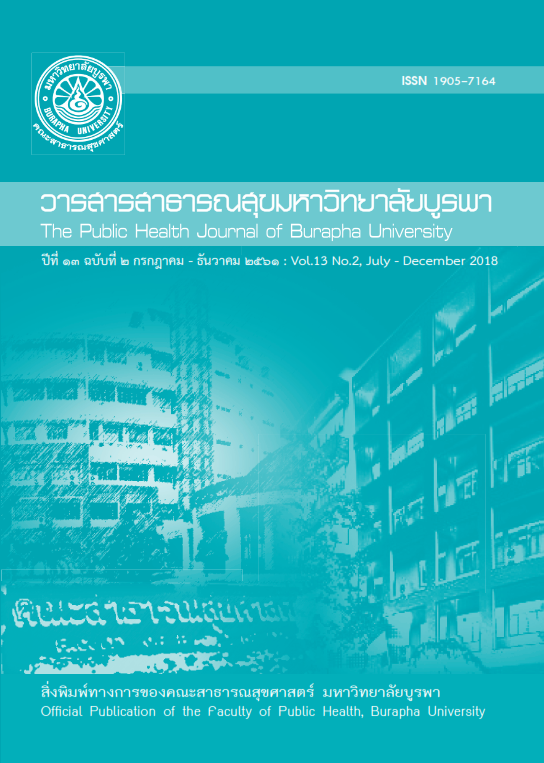การหกล้มในผู้สูงอายุที่กระดูกพรุน: สาเหตุและการป้องกันด้วยการออกกำลังกาย
Main Article Content
บทคัดย่อ
สังคมไทยได้ก้าวเข้าสู่สังคมผู้สูงอายุอย่างเต็มตัว เนื่องด้วยการพัฒนาทางการแพทย์ที่ส่งผลให้มีสุขภาพที่ดีและอายุยืนยาว มีรายงานว่าจะมีผู้สูงอายุมากถึงร้อยละ 18 ในปีพุทธศักราช 2563 ต้องมีการเตรียมความพร้อมทางการแพทย์มากยิ่งขึ้นเพื่อรองรับการเปลี่ยนแปลงของสังคม จึงเป็นบทบาทของบุคลากรทางการแพทย์ โดยเฉพาะนักกายภาพบำบัดที่ต้องพัฒนารูปแบบการดูแลสุขภาพผู้สูงอายุ และสิ่งที่ดีที่สุดคือการป้องกัน โดยสอดคล้องกับการเปลี่ยนแปลงทางสรีรวิทยาและทางกล้ามเนื้อกระดูก ข้อต่อ และระบบประสาท ที่เสื่อมถอยลงในผู้สูงอายุ ซึ่งหนึ่งในปัจจัยที่เสี่ยงคือ”ภาวะกระดูกพรุน” เสี่ยงต่อการหักเมื่อล้ม ทำให้สูญเสียการเคลื่อนไหว ไม่มั่นใจ กระทบต่อความสามารถในการทรงท่า ทั้งขณะอยู่นิ่งและขณะเคลื่อนไหว ในกิจกรรมที่แตกต่างในการดำรงชีวิตประจำวัน เมื่อทรงท่าได้ไม่ดี จะทำให้เสี่ยงต่อการล้ม ซึ่งอาจจะทำให้กระดูกหัก ทำให้คุณภาพชีวิตลดลง จึงเป็นที่มาและความสำคัญในการตรวจประเมินการทรงท่าและความเสี่ยงต่อการล้มในผู้สูงอายุที่มีภาวะกระดูกพรุน เพื่อค้นความเสี่ยงแล้ว นำไปสู่การวางแผนการออกกำลังกายด้วยการทรงท่า ป้องกันการล้ม ป้องกันการพิการ ลดภาระการดูแลของบุตร ภาระต่อสังคม และลดค่าใช้จ่ายในการดูแลสุขภาพจากภาครัฐ
Article Details
References
2. สำนักส่งเสริมและพิทักษ์ผู้สูงอายุ. สถานการณ์ประชากรผู้สูงอายุ. แผนผู้สูงอายุแห่งชาติ. 2552; 2: 6-10.
3. สํานักงานสถิติแห่งชาติ. แนวโน้มประชากรสูงอายุ. สรุปผลที่สําคัญการสำรวจประชากรสูงอายุในประเทศไทย 2550; 5-17
4. Miller, C. A. Nursing for Wellness in Older Adults. 5th Ed. Spearhead. 2009.
5. Ryan, R.M. & Frederic, C. On energy, personality, and health: Subject vitality as a dinamic reflecion of well-being. Jounal of personality 1997; 65: 529-65.
6. Kado DM, Huang MH, Karlamangla AS, Barrett-Connor E, Greendale GA. Hyperkyphotic posture predicts mortality in older community-dwelling men and women. a prospective study. J Am Geriatr Soc 2004; 52: 1662-67.
7. Sinaki M, Lynn SG. Reducing the risk of falls through proprioceptive dynamic posture training in osteoporotic women with kyphotic posturing. A randomized pilot study. Am J Phys Med Rehabil 2002; 81: 241–6.
8. Takahashi W, Fujii H, Ide M, Takagi S, Shinohara Y. Atherosclerotic changes in intracranial and extracranial large arteries in apparently healthy persons with asymptomatic lacunar infarction. J Stroke Cerebrovasc Dis 2005; 14(1): 17-22.
9. Cotter VT, Strumpf NG, editor. Advanced practice nursing with order adult: Clinical guidelines. New York: Mcgrew-Hill; 2002.
10. สุทธิชัย จิตะพันธ์กุล. ปัญหาสุขภาพของผู้สูงอายุไทย นนทบุรี : สถาบันวิจัยสาธารณสุขไทย, โครงการส่งเสริมสุขภาพ และการป้องกันภาวะหกล้ม และผลแทรกซ้อนในผู้สูงอายุโดยแพทย์เวชศาสตร์ผู้สูงอายุ : the health promotion and prevention of instability and its complication in the elderly by geriatricians กรุงเทพฯ: มหาวิทยาลัยมหิดล; 2544.
11. Kilner PJ, Henein MY, Gibson DG. Our tortuous heart in dynamic mode--an echocardiographic study of mitral flow and movement in exercising subjects. Heart Vessels. 1997; 12 (3):103-10.
12. Borel, Alescio-Lautier. Posture and cognition in the elderly: Interaction and contribution to the rehabilitation strategies. Neurophysiologie Clinique 2014: 44; 95-107.
13. พจนานุกรมไทยฉบับราชบัณฑิตยสถาน. 2542. [เข้าถึงเมื่อ 20 เมษายน 2557]. เข้าถึงได้จากhttps://rirs3.royin.go.th/new-search/word-searchallx.asp.
14. Rubenstein, L. Z., Robbins, A. S., Josephson, K. R., Schulman, B. L., and Osterweil, D. The value of assessing falls in an elderly population. A randomized clinical trial. Annals of Internal Medicine 1990; 113(4): 308-16.
15. Piphatvanitcha N., Kespichayawattana J.,Aungsuroch Y. and &Magilvy J. K. State of science: Falls prevention program in community-dwelling elders. Thai Journal of Surgery 2007; 28: 90-97.
16. ลัดดา เถียมวงศ์, สุทธิชัย จิตะพันธ์กุล และลักษณา ปัญญาชีวิน. การทดสอบประสิทธิภาพ
ของเครื่องมือประเมินความเสี่ยงของการเกิดหกล้ม (Thai FRAT) ของผู้สูงอายุที่อาศัยอยู่ในชุมชน. วารสารพฤฒาวิทยา 2547; 5(2): 14524.
17. Rubenstein LZ. Falls in older people: epidemiology, risk factors and strategies forprevention. Age Ageing 2006; 35(2): 37-47.
18. Aekplakorn W. The report of Thailand population national health examination survey IV 2008-2009. Nonthaburi: The Graphico Systems; 2010.
19. Jitapunkul S, Songkhla MN, Chayovan N, et al. Falls and their associated factors: a national survey of the Thai elderly. J Med Assoc Thai 1998; 81: 233.
20. Hadjistavropoulos T, Delbaere K & Fitzgerald T.D. Reconceptualizing the role of fear of falling and balance confidence in fall risk. Ageing and Health 2010; 23(1): 3-23
21. แดนเนาวรัตน์ จามรจันทร์, จิตอนงค์ ก้าวกสิกรรม, สุจิตรา บุญหยง. โครงการ “การศึกษาเรื่องการทรงตัว และหกล้มในผู้สูงอายุไทย” [รายงานวิจัยฉบับสมบูรณ์ สำนักงานกองทุนสนับสนุนการวิจัย (สกว.)]. กรุงเทพมหานคร: สำนักงานกองทุนสร้างเสริมสุขภาพ; 2548.
22. Deshpande, N., Metter, E. J., Bandinelli, S., Lauretani, F., Windham, B. G., and Ferrucci, L. Psychological, physical and sensory correlates of fear of falling and consequentactivity restriction in the elderly: The InCHIANTI study. American Journal ofPhysical Medicine and Rehabilitation 2008; (87)5: 354-362.
23. Gillespie, S. M., and Friedman, S. M. Fear of falling in new long-term care enrollees.Journal of the American Medical Directors Association 2007; (8)5: 307-313.
24. Hellstrom, K., Vahlberg, B., Urell, C., and Emtner, M. Fear of falling, fall-relatedself-efficacy, anxiety and depression in individuals with chronic obstructive pulmonarydisease. Clinical Rehabilitation 2009; 23: 1136-44.
25. ประเสริฐ อัสสันตชัย. ปัญหาสุขภาพที่พบบ่อยในผู้สูงอายุและการป้องกัน. กรุงเทพฯ: ยูเนี่ยน ครีเอชั่น; 2552.
26. เปรมกมล ขวนขวาย. ปัจจัยที่เกี่ยวข้องกับการหกล้มของผู้สูงอายุที่อาศัยอยู่ในชุมชน [วิทยานิพนธ์สาธารณสุขศาสตรมหาบัณฑิต]. ขอนแก่น: มหาวิทยาลัยขอนแก่น; 2550.
27. พิมพ์วรินทร์ ลิ้มสุขสันต์. ปัจจัยทำนายการพลัดตกหกล้มของผู้สูงอายุ.[ วิทยานิพนธ์พยาบาลศาสตร์]. มหาบัณฑิต: มหาวิทยาลัยธรรมศาสตร์; 2552.
28. Friedman, S. M., Munoz, B., West, S. K., Rubin, G., & Fried, L. P. Fall and fear of falling: Which come first. A longitudinal prediction model suggests for primary and secondary prevention. American Geriatrics Society 2002. 50.
29. บรรลุ ศิริพานิช. ปัญหาสุขภาพของผู้สูงอายุไทย (พิมพ์ครั้งที่3) . กรุงเทพฯ: คบไฟ; 2543.
30. ประเสริฐ อัสสันตชัย. เอกสารประกอบการอบรมด้านผู้สูงอายและความชรา พ.ศ. 2544. สมาคมพฤฒาวิทยาและเวชศาสตร์ผู้สูงอายุไทย. กรุงเทพฯ: โรงพิมพ์แห่งจุฬาลงกรณ์มหาวิทยาลัย; 2544.
31. Limpawattana P, Sutra S, Thavompitak Y, Chindaprasirt J, Mairieng P. Geriatric hospitalizations due to fall-related injuries. J Med Assoc Thai 2012; 95(7): 235–39.
32. Suzuki, M., Ohyama, N., Yamada, K., and Kanamori, M. The relationship between fear of falling, activities of daily living and quality of life among elderly individuals. Nursing and Health Sciences 2002; 4: 155-61.
33. Sloane P, Blazer D, George LK. Dizziness in a community elderly population. J Am Geriatr Soc 1989; 31: 101–8.
34. Overstall PM, Exton-Smith AN, Imms FJ, Johnson AL. Falls in the elderly related to postural imbalance. BMJ 1977; 1: 261-4.
